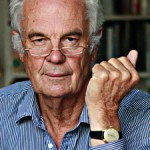No proof that Iran wants the bomb
By Jonathan Power
Many of us doubt that Iran is on the way to build a nuclear bomb. Trying to find the truth is not easy. It was a bit of a one sided conversation since I don’t know the inner workings of the International Atomic Energy Agency, the UN body that monitors nuclear developments. But Robert Kelly, a nuclear energy engineer and ex-department director at the IAEA, has brought me up to speed.
According to him the evidence described in a widely quoted report issued in November 2011 by the Director General of the IAEA, Yukiya Amano, is sketchy. Furthermore, the way the data has been presented produces a sickly sense of déjà vu.
It is accepted that Iran at one time had a nuclear weapons’ programme. The country’s enormous investment in a secret underground uranium-enrichment complex in the city of Natanz is proof of a clandestine operation. The military plutonium-production reactor in Arak is yet another indicator.
However, in the 2007 National Intelligence Estimate, US agencies concluded ‘with high confidence’ that Iran had halted its nuclear weapons’ programme in late 2003. Similarly, until this year, the IAEA had consistently reported that it had no information suggesting Iran had a nuclear weapons’ programme after 2004.
The question, says Kelley, is whether there is evidence that it was restarted after it was shut down in 2003. In the 24-page document all but three of the items that were offered as proof of a possible nuclear weapons’ programme are either undated or refer to events before 2003.
What of the three pieces of dated recent evidence that Iran’s nuclear weapons’ programme may have been reactivated?
Two relate to alleged modelling studies on nuclear warhead design in 2008 and 2009, and alleged ‘experimental research’ on scaling down and optimizing a nuclear weapons-relevant high-explosives package. They are attributed only to ‘two member states’ so the sourcing is impossible to evaluate. In addition, their validity is called into question by the report’s handling of the third piece of evidence.
That evidence, according to the report, tells us that Iran embarked on a four-year programme, starting around 2006, to validate the design of a device to produce a burst of neutrons that could initiate a fission chain reaction. Though it is not clear what source the report is relying on it is certain that this project was at the centre of what appeared to be a disinformation campaign.
In 2009 the IAEA received a two-page document purporting to come from Iran describing the same alleged work. Mohamed ElBaradei, then the agency’s Director General, rejected the information because there was no chain of custody for the paper, no clear source and no document markings, date of issue or anything else that could establish its authenticity. It appeared to be a hoax.
Kelley regrets that ElBaradei did not speak out more vehemently before the USA went to war in Iraq about the falsification of evidence- the 1995 faked documents, additional forgeries sent to the IAEA in 2003 and others.
ElBaradei labelled documents sent to the IAEA about Iraq’s attempts to acquire uranium from Africa ‘not authentic’. A better description would have been ‘blatant and amateurish forgeries’. He provided evidence that aluminium tubes the US said were for nuclear centrifuges were actually for rockets, but he did not make public the supporting engineering details. The truth was lost in US Secretary of State Colin Powell’s scandalous detailing of Iraq’s supposed weapons of mass destruction which was wrong in almost every respect.
ElBaradei’s successor has similarly fallen short by failing to note in his report the earlier doubts that Iran was continuing to develop a neutron-producing device. If Amano has found new reasons to overlook the many questionable aspects of this story he should present them. Given past doubts about the episode his reporting on it should be above reproach.
When it comes to accurately accounting for potential diversions of nuclear material the IAEA has gone about its work with precision. It needs to be just as exacting when it delves into allegations about Iran’s weapons activities.
Iran deserves tough scrutiny. It claims to have given up its nuclear weapons’ ambitions yet repeatedly acts as if it has something to hide. Half of Kelley is sceptical. Perhaps, after all, the Iranians may have an ongoing weaponization programme. The uncertainty must be resolved, and it can only be if Iran opens up to the IAEA inspectors.
At the same time we should not again be held hostage to forgeries and the spinning of data to make the worst case. If Iran is developing nuclear weapons let it be proved through the analysis of current and solid information- not based on recycled, discredited data. Let us not have a repeat afterwards, concludes Kelly, of the anguished articles from officials who kept their misgivings on Iraq to themselves. Let us get all the facts on the table now.
Copyright: Jonathan Power
Jonathan Power
jonatpower@aol.com

This is a much needed analysis. It is clear that most of those who have commented on the IAEA report have not read it carefully but are acting on the press releases issued by the USA administration. It should be remembered that IAEA has a Board of Directors appointed by governments. The Board acted against the advice of the IAEA experts when it took the case of Iran’s non-compliance to the UN Security Council. The IAEA inspectors reported that they had obtained cooperation from the Iranian authorities. The IAEA has now become very politicized. The new director Mr Amano seems to be much less independent than hit predecessor ElBaradei.
But, again, we should ask different questions: What is the US agenda regarding Iran? How can an attack from Israel be prevented? Is a dialogue still possible? How can we avoid a war?